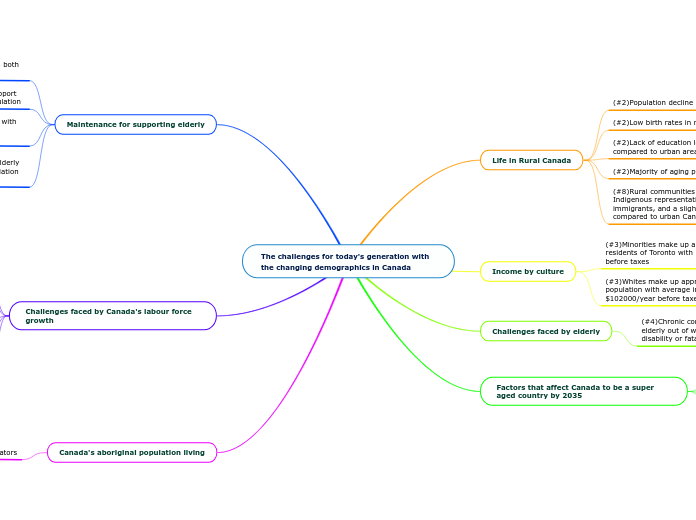The challenges for today's generation with the changing demographics in Canada
Life in Rural Canada
(#2)Population decline in rural areas
(#2)Low birth rates in rural areas
(#2)Lack of education levels in rural areas as compared to urban areas
(#2)Majority of aging population
(#8)Rural communities tend to have stronger Indigenous representation, fewer recent immigrants, and a slightly older population compared to urban Canada.
Income by culture
(#3)Minorities make up almost 68% of the residents of Toronto with $32000/year income before taxes
(#3)Whites make up approximately 49% of the population with average individual income of $102000/year before taxes.
Challenges faced by elderly
(#4)Chronic conditions effect over 57% of elderly out of which 35% are at a higher disability or fatality risk
Factors that affect Canada to be a super aged country by 2035
(#4)Low birth rate
(#4)Increase in number of elderly due to healthy living
(#4)Increase of number of people reach age over 85
(#4)Increase in difference between male and female population
Maintenance for supporting elderly
(#4)Elderly require - age-friendly housing, both in Urban and rural areas.
(#4)Required- health services that can support diverse older people due to the aging population
(#4)System cannot deal with older people with more than one chronic conditions due to transitions between the health system
(#5)Demand for long term care beds for elderly could nearly double due to the aging population in the next 15-20 years
(#5)New beds/manufacture of them would require approximately $64 billion in capital while operating the new beds would require roughly $130 billion between 2018 and 2035
Challenges faced by Canada's labour force growth
(#6)Canada faces new challenges such as an ageing population and declining birth rate, and immigrants have helped address these by contributing to Canada’s labour force growth
(#10)By 2012, the worker-to-retiree ratio had dropped to 4.2 to 1
(#10)Projections put the ratio at 2 to 1 by 2036, at which time five million Canadians are set to retire
(#11)The average age of the population is moving up as life expectancy increases, birth rates decline and the baby boomer generation ages
(#11)Old-age dependency ratio signals amount of taxes an individual will pay overtime
(#11) This ratio is increasing, result of greater life expectancy, declining birth rate and other factors
Anyone born between 1946 and 1964, makes up the majority of seniors, and as they retire in increasingly greater numbers, an imbalance in the labour workforce will continue to grow, creating all sorts of pressure on governments and businesses
Canada's aboriginal population living
(#7)Social Indicators
(#7)Aboriginals are far more likely to be victims of
violent crimes than non-aboriginals
